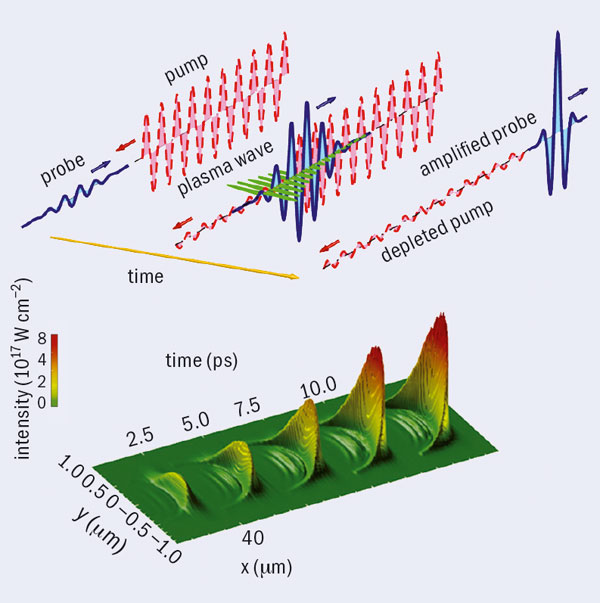
Researchers using the first large-scale particle-in-cell simulations have found that Raman amplification of laser beams in a plasma can produce multi-petawatt peak powers – albeit in a definite parameter window – without the plasma medium being destroyed through instabilities. The control of these instabilities promises big reductions in costs and complexity for producing ultra-intense laser pulses, which in turn would allow greater access to higher intensities for use in inertial laser fusion or in laser-based particle accelerators. The process also scales to short wavelengths allowing, for example, the compression of free-electron laser pulses to durations of an attosecond.
Since the invention of the laser 50 years ago, the drive to produce increasingly intense lasers for investigating physical processes at the intensity frontier has required larger amplifying media. This progress has followed a path similar to development in accelerators as described by the Livingston curve: as one technique saturates another is discovered. At present, conventional amplifying media are based on solid-state lasers, which have already proved successful at reaching powers on the petawatt scale. Such lasers, when focused, can produce intensities of the order of 1021 W/cm2 on target, equivalent to 109 atmospheres, the pressure found inside stars. However, the intensity threshold for the breakdown of the optical components in these systems demands metre-scale beams.
A promising new technique uses a much smaller amplifying medium – millimetre-diameter plasmas, which can be 100,000 times smaller than conventional optics, making the system compact and less expensive. Raoul Trines and colleagues of the Central Laser Facility, STFC Rutherford Appleton Laboratory, St Andrews University and the Instituto Superior Técnico, Lisbon, have made the first systematic study of high-power Raman amplification. In this process a long pump pulse and a counter-propagating short probe pulse are sent into a plasma where they couple through a plasma wave and energy transfers from the pump to the probe pulse, resulting in amplification (see figure).
Using multidimensional, fully relativistic particle-in-cell simulations the team has discovered how to produce short multi-petawatt laser pulses while controlling instabilities, for example, from forward Raman scattering. They find that although increasing the pump intensity or plasma density can lead to efficiency in the amplification process, it can also increase the instabilities in both the pump and the probe. Nevertheless, they identify a parameter regime in which a 4 TW, 700 μm full-width at half-maximum (FWHM), 25-ps-long laser pulse with 800 nm wavelength can be amplified to 2 PW peak intensity with 35% efficiency, as the lower part of the figure shows.
One major application of ultra-high-power laser systems is laser-driven electron acceleration in plasma. Earlier this year, Samuel Martins and colleagues of the Instituto Superior Técnico and University of California Los Angeles, found that electrons can be accelerated to beyond 10 GeV when the driver pulse contains 300 J in 110 fs (2.8 PW peak power). Starting from a kilo-joule pump laser beam with a duration of 100 ps, such a pulse could be produced via Raman amplification in a plasma column only 15 mm long and just a few millimetres in diameter. Producing the same pulse via conventional glass optics would require gratings that are at least one metre across. This is just one of the many applications of high-power lasers that could benefit hugely from the application of the novel technique of Raman amplification.
Further reading
R M G M Trines et al. 2010 Nature Phys. doi:10.1038/nphys1793.
S Martins et al. 2010 Nature Phys. 6 311.





